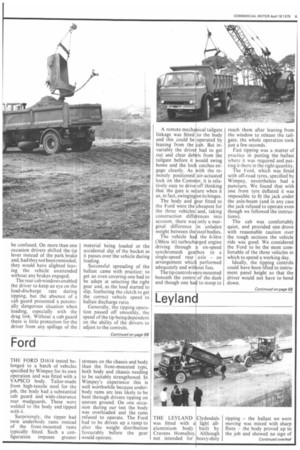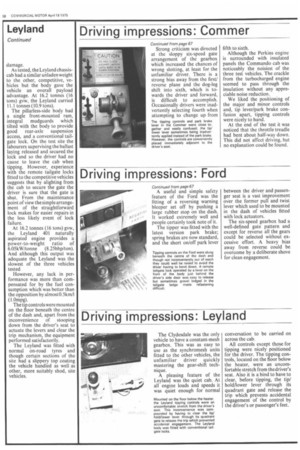Commer
Page 68

Page 69

Page 70

If you've noticed an error in this article please click here to report it so we can fix it.
THE COMMER Commando G1611 tested had the most powerful engine of the three vehicles. On the made-up road section the Commer outmatched its competitors for acceleration through the gears, especially when laden. The Chrysler six-speed synchromesh gearbox was supplemented by an Eaton two-speed axle which though easy, and con venient, to use on certain occasions was in my view an unnecessary extra, at least for this type of operation. With a power-to-weight ratio of 6.7kW/ tonne (9.2bhp/ton) I would consider a six-speed transmission adequate without a split axle. The standard for this model is a five-speed synchromesh gearbox; the six-speed plus two-speed axle costs an additional £77.
As tested the Commer had an unladen weight of just over 5.6 tonnes (5.5 tons) and this compared favourably with the other vehicles when taking body construction differences into account. The 3.7m (12ft lin) wheelbase tipper — the shortest wheelbase version available — coped easily with the wet chalk on the unmade sections. But larger mirrors would have made life easier when passing through scaffolding rigged around bridges still under construction.
Tipping with the Commando was made easy by the specification of an air-operated tailgate lock actuated from inside the cab — there was no need for the driver to leave the cab. But after locking the gate there was the nagging doubt that the lock might not have engaged properly and that the ballast would spill from the open gate during loading.
All the tip controls were on the driver's right-hand side, adjacent to the rear of the seat. The tip lever was in line with and directly behind the park brake, and the two could easily be confused. On more than one occasion drivers shifted the tip lever instead of the park brake and, had they not been reminded, they would have alighted leaving the vehicle unattended without any brakes engaged.
The rear cab windows enabled the driver to keep an eye on the load-discharge rate during tipping, but the absence of a cab guard presented a potentially dangerous situation when loading, especially with the drag link. Without a cab guard there is little protection for the driver from any spillage of the material being loaded or the accidental slip of the bucket as it passes over the vehicle during loading.
Successful spreading of the ballast came with practice; to get an even covering one had to be adept at selecting the right gear and, as the load started to slip, feathering the clutch to get the correct vehicle speed to ballast discharge ratio.
Generally, the tipping operation passed off smoothly, the speed of the tip being dependent on the ability of the drivers to adjust to the controls. Strong criticism was directed at the sloppy six-speed gate arrangement of the gearbox which increased the chances of wrong slotting, at least for the unfamiliar driver. There is a strong bias away from the first/ reverse plane and the dog-leg shift into sixth, which is towards the driver and forward, is difficult to accomplish. Occasionally drivers were inadvertently selecting fourth when attempting to change up from
The tipping controls and park brake lever in the Commer were close together and easily confused, the tip/ lower lever sometimes being inadvertently applied instead of the park brake. However, the controls are conveniently placed immediately adjacent to the driver's seat.
fifth to sixth.
Although the Perkins engine is surrounded with insulated panels the Commando cab was noticeably the noisiest of the three test vehicles. The crackle from the turbocharged engine seemed to pass through the insulation without any appreciable noise reduction.
We liked the positioning of the major and minor controls and, tip lever/park brake confusion apart, tipping controls were nicely to hand.
At the end of the test it was noticed that the throttle treadle had bent about half-way down. This did not affect driving, but no explanation could be found.








































































































































